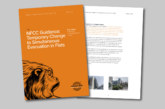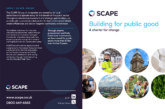Grant UK comments on the recent changes to the Building Regulations — Part L (Conservation of fuel and Power), Part F (Ventilation) and Part O (Setting Standards for overheating in new residential buildings).
In December 2021, the UK Government issued the latest Approved Documents that make up the Building Regulations, incorporating the first major changes in almost a decade. The changes are part of Government policy decisions highlighted in the Future Homes Standard (FHS) that is currently due to be implemented in 2025.
The FHS will mandate that homes will produce at least a 75% reduction of CO2 emissions. The recently released Part L will offer an average reduction of 27% to 30% in CO2 emissions relative to the 2013 version of the document. The changes to Part L are therefore a stepping stone to get us to the bigger ask of the Future Homes Standard.
 “From Grant UK’s perspective, we will be looking into the finer detail of the documents over the coming months but as it stands today, these changes form a very real beginning for the decarbonisation of heat and takes away any doubt over what the future looks like,” explained Neil Sawers, Commercial Technical Manager for Grant UK.
“From Grant UK’s perspective, we will be looking into the finer detail of the documents over the coming months but as it stands today, these changes form a very real beginning for the decarbonisation of heat and takes away any doubt over what the future looks like,” explained Neil Sawers, Commercial Technical Manager for Grant UK.
“Starting now, there are real challenges ahead — like upskilling the workforce to ensure our industry have the numbers of highly trained individuals required to deliver a lower carbon heating solution to our customers.”
Grant UK will also await further clarification from the Government on some of the new elements included in the Regulations.
“On initial reading, when a wet heating system has either been newly installed or fully replaced in an existing building (this has still to be clarified but we believe this will include the heating appliance, emitters and associated pipework), it should be sized to allow the space heating system to meet the heating needs of the dwelling but at a maximum flow temperature of 55°C or lower,” continued Neil.
“If this is not possible, the space heating system should be designed to the lowest design temperature possible that will still meet the heating needs of the dwelling. An appendix has also been added which sets out a ‘Good Practice’ specification for a new home design to be heated by a heat pump.”
For existing homes, uplifts to both Part L and F have new minimum efficiency standards. This includes a new way of calculating whole house heat losses for new extensions. A transition period now starts, which will end in June 2022 when these new regulations will come into effect.
Late 2021 also saw the release of several other important consultations and documents. The Department for Business, Energy & Industrial Strategy (BEIS) released its extensive Q&A on the Heat Pump Ready programme. In October 2021, the Government response to Clean Heat Grant proposals within the ‘Future support for low carbon heat’ consultation named Ofgem as the intended administrator of the Boiler Upgrade Scheme (BUS), formerly known as the Clean Heat Grant. Ofgem consequently launched a consultation, seeking views on its proposed administration of the BUS.
“This is an extremely busy time as the industry absorbs the ramifications of all these changes. What is for certain is that everyone; manufacturers, merchants and installers will need to adapt to the new regulations very quickly. The good news is that Grant UK has significant plans in place to meet the challenges ahead and be with them on the journey that lies ahead,” says Neil.









